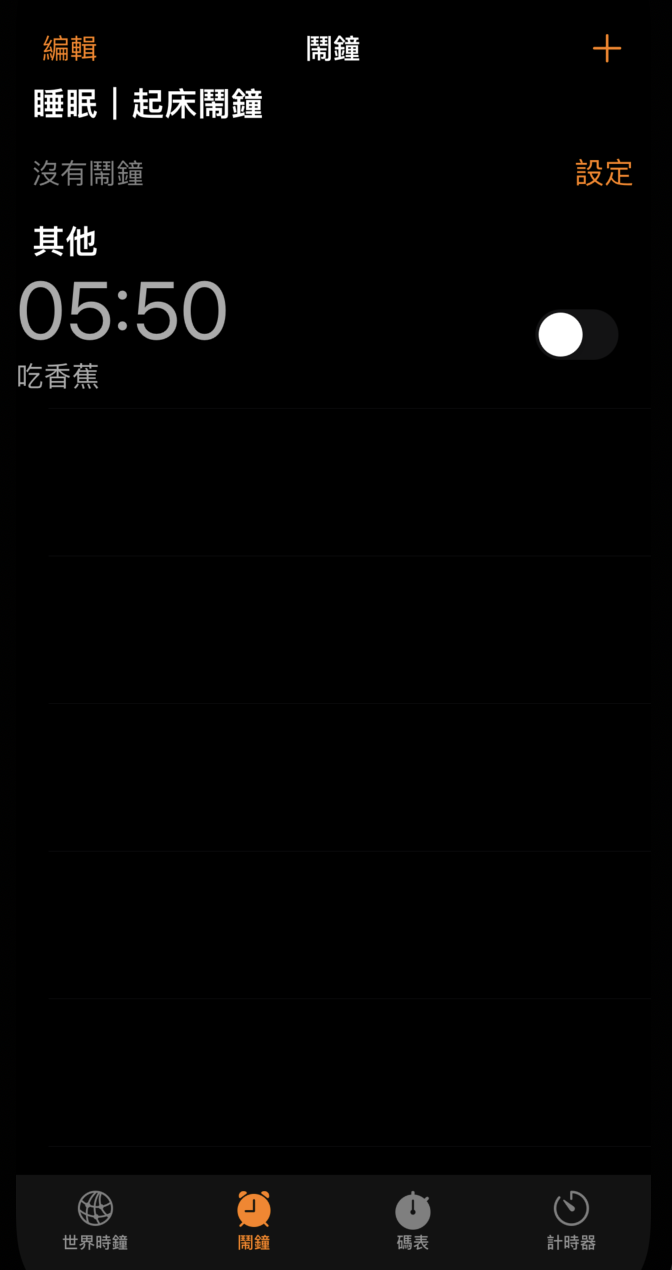我們已經將第一個Section下的Cell設置完畢了,接下來馬上來實作第二個Section的Cell,
可以看到有兩個Label,一個UISwitch(之前有介紹過的)
讓我們的門面更好看吧!
let alarmTimeLabel: UILabel = {
let label = UILabel()
// Label字體大小
label.font = UIFont.systemFont(ofSize: 50)
// 先暫時給個假定時間
label.text = "05:50"
// Label文字顏色
label.textColor = .lightGray
return label
}()
let alarmNoteLabel: UILabel = {
let label = UILabel()
label.text = "吃香蕉"
label.textColor = .lightGray
return label
}()
override init(style: UITableViewCell.CellStyle, reuseIdentifier: String?) {
super.init(style: style, reuseIdentifier: reuseIdentifier)
self.backgroundColor = .clear
// 設定accessoryView 為 UISwitch
self.accessoryView = UISwitch(frame: .zero)
setViews()
setLayouts()
}
接著設定Layou和將元件加入Cell,整體的Code看起來會像以下
class AlarmOtherTableViewCell: UITableViewCell {
static let identifier = "alarmOtherTableViewCell"
// MARK: - IBOutLets
let alarmTimeLabel: UILabel = {
let label = UILabel()
// Label字體大小
label.font = UIFont.systemFont(ofSize: 50)
// 先暫時給個假定時間
label.text = "05:50"
// Label文字顏色
label.textColor = .lightGray
return label
}()
let alarmNoteLabel: UILabel = {
let label = UILabel()
label.text = "吃香蕉"
label.textColor = .lightGray
return label
}()
// MARK: - Init
override init(style: UITableViewCell.CellStyle, reuseIdentifier: String?) {
super.init(style: style, reuseIdentifier: reuseIdentifier)
self.backgroundColor = .clear
// 設定accessoryView 為 UISwitch
self.accessoryView = UISwitch(frame: .zero)
setViews()
setLayouts()
}
required init?(coder: NSCoder) {
fatalError("init(coder:) has not been implemented")
}
// MARK: - setViews
func setViews() {
self.addSubview(alarmTimeLabel)
self.addSubview(alarmNoteLabel)
}
// MARK: - setLayouts
func setLayouts() {
alarmTimeLabel.snp.makeConstraints { make in
make.top.equalTo(self)
}
alarmNoteLabel.snp.makeConstraints { make in
make.top.equalTo(alarmTimeLabel.snp.bottom)
make.bottom.equalTo(self).offset(-10)
}
}
}
Cell做好之後,接著就是去要用這個Cell的TableView去註冊他,因此回到「AlarmViewController」內
找到「alarmTableView」,加入Code去註冊他
let alarmTableView: UITableView = {
let tableView = UITableView()
// 註冊 WakeUpTableViewCell
tableView.register(WakeUpTableViewCell.self, forCellReuseIdentifier: WakeUpTableViewCell.identifier)
// 註冊 AlarmOtherTableViewCell
tableView.register(AlarmOtherTableViewCell.self, forCellReuseIdentifier: AlarmOtherTableViewCell.identifier)
// 將alarmTableView的背景色更改為灰色
tableView.backgroundColor = .black
return tableView
}()
註冊完後,只要把TableView Delegate設定一下Cell應該就會出來囉!
因此找到TableView Delegate的「cellForRowAt」,並新增Code讓Cell顯示
func tableView(_ tableView: UITableView, cellForRowAt indexPath: IndexPath) -> UITableViewCell {
switch indexPath.section {
// 第一個Header要顯示哪個Cell
case 0:
// 將實作的WakeUpTableViewCell實體化,並顯示於第一個Section的畫面上
guard let cell = tableView.dequeueReusableCell(withIdentifier: WakeUpTableViewCell.identifier, for: indexPath) as? WakeUpTableViewCell else { return UITableViewCell() }
return cell
case 1:
// 將實作的AlarmOtherTableViewCell實體化,並顯示於第二個Section的畫面上
guard let cell = tableView.dequeueReusableCell(withIdentifier: AlarmOtherTableViewCell.identifier, for: indexPath) as? AlarmOtherTableViewCell else { return UITableViewCell() }
return cell
default:
// 由於 cellForRowAt 這個function一定要return 一個 TableViewCell
// 因此其餘的Section皆回傳空的Cell
return UITableViewCell()
}
}
別忘了到TableView Delegate的「numberOfRowsInSection」內,新增要回傳的Cell個數
func tableView(_ tableView: UITableView, numberOfRowsInSection section: Int) -> Int {
switch section {
case 0:
// 第一個Section下顯示一個Cell即可
return 1
case 1:
// 第二個Section先暫時顯示一個Cell
return 1
default:
// 其餘不顯示任何Cell
return 0
}
}
執行程式看看吧!
哇靠!太美了吧![]()
但有沒有發現UISwitch的背景色怪怪的?好像太黑了
明天再來對UISwitch好好修改造改造![]()
